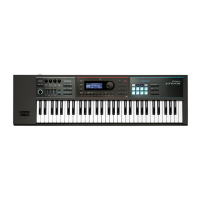6
Patch Mode
WAVE
Parameter Value/Explanation
*
1–
*
4
Specify the on/o status of tones 1–4. If a tone is on, a “
(
” mark is shown.
OFF, ON
Wave Group
Selects the group for the waveform that is to be the basis of the tone.
INTA, B Waveforms stored in internal
EXP Waveforms for expansion sounds
Wave No. L (Mono)
Wave No. R
Selects the basic waveform for a tone. Along with the Wave number, the
Wave name appears at the lower part of the display.
When in mono, only the left side (L) is specied. When in stereo, the right
side (R) is also specied.
OFF, 1–2402 (The upper limit will depend on the wave group.)
Wave Gain
Sets the gain (amplication) of the waveform. The value changes in 6 dB
(decibel) steps—an increase of 6 dB doubles the waveform’s gain.
If you intend to use the Booster to distort the waveform’s sound, set this
parameter to its maximum value (p. 7).
-6, 0, +6, +12
Wave Tempo Sync
When you wish to synchronize a Phrase Loop to the clock (tempo), set this
to “ON.”
OFF, ON
MEMO
Phrase loop refers to the repeated playback of a phrase that’s been pulled
out of a song (e.g., by using a sampler).
Wave FXM Switch
Sets whether FXM will be used (ON) or not (OFF).
OFF, ON
MEMO
FXM (Frequency Cross Modulation) uses a specied waveform to apply
frequency modulation to the currently selected waveform, creating
complex overtones. This is useful for creating dramatic sounds or sound
eects.
Wave FXM Color
Species how FXM will perform frequency modulation. Higher settings
result in a grainier sound, while lower settings result in a more metallic
sound.
1–4
Wave FXM Depth
Species the depth of the modulation produced by FXM.
0–16
Tone Delay Mode
Selects the type of tone delay.
NORM
The tone begins to play after the time specied in the Tone
Delay Time has elapsed.
Note on
No Tone Delay
Delay time
Note o
HOLD Although the tone begins to play after the time specied
in the Tone Delay Time has elapsed, if the key is released
before the time specied in the Tone Delay Time has
elapsed, the tone is not played.
Note on Note o
No sound played
OFF-N
Rather than being played while the key is pressed, the tone
begins to play once the period of time specied in the
Tone Delay Time has elapsed after release of the key. This is
eective in situations such as when simulating noises from
guitars and other instruments.
Note on Note o
Delay time
Parameter Value/Explanation
OFF-D
Rather than being played while the key is pressed, the tone
begins to play once the period of time specied in the
Tone Delay Time has elapsed after release of the key. Here,
however, changes in the TVA Envelope begin while the key
is pressed, which in many cases means that only the sound
from the release portion of the envelope is heard.
Note on Note o
Delay time
MEMO
If you have selected a waveform that is a decay-type sound (i.e., a sound that fades away
naturally even if the key is not released), selecting “OFF-N” or “OFF-D” may result in no sound
being heard.
Tone Delay Time
Species the time from when the key is pressed (or if the Delay Mode is set
to “OFF-N” or “OFF-D,” the time from when the key is released) until when
the tone will sound.
0–127, note
TMT
Parameter Value/Explanation
Structure Type
1 & 2, 3 & 4
Determines how tone 1 and 2, or tone 3 and 4 are connected.
The following 10 dierent Types of combination are available.
1
With this type, tones 1 and 2 (or 3 and 4) are independent.
Use this type when you want to preserve PCM sounds or
create and combine sounds for each tone.
2
This type stacks the two lters together to intensify the
characteristics of the lters. The TVA for tone 1 (or 3) controls
the volume balance between the two tones.
3 This type mixes the sound of tone 1 (3) and tone 2 (4),
applies a lter, and then applies a booster to distort the
waveform.
4
This type applies a booster to distort the waveform, and
then combines the two lters. The TVA for tone 1 (or 3)
controls the volume balance between the two tones and
adjusts booster level.
5
This type uses a ring modulator to create new overtones,
and combines the two lters. The tone 1 (3) TVA will control
the volume balance of the two tones, adjusting the depth of
ring modulator.
6
This type uses a ring modulator to create new overtones,
and in addition mixes in the sound of tone 2 (4) and stacks
the two lters. Since the ring-modulated sound can be
mixed with tone 2 (4), tone 1 (3) TVA can adjust the amount
of the ring-modulated sound.
2

